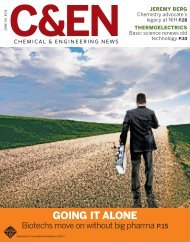Chemical & Engineering News Digital Edition ... - IMM@BUCT
Chemical & Engineering News Digital Edition ... - IMM@BUCT
Chemical & Engineering News Digital Edition ... - IMM@BUCT
Create successful ePaper yourself
Turn your PDF publications into a flip-book with our unique Google optimized e-Paper software.
TOP 25 UNIVERSITIES IN 2006 R&D SPENDING<br />
Top schools invested only 2.5% of their R&D funds in chemistry<br />
RANK<br />
LIFE<br />
PHYSICAL<br />
ENVIRON-<br />
MENTAL<br />
MATH &<br />
COMPUTER OTHER<br />
2006 2005 $ MILLIONS SCIENCES a ENGINEERING SCIENCES b CHEMISTRY c SCIENCES SCIENCES SCIENCES TOTAL<br />
1 1 Johns Hopkins U d $702 $467 $140 $13 $40 $97 $53 $1,500<br />
2 3 U of Wisconsin, Madison 508 93 56 18 83 21 72 832<br />
3 4 U of California, Los Angeles 610 52 59 18 11 23 57 811<br />
4 2 U of Michigan 481 152 41 18 11 12 103 800<br />
5 5 U of California, San Francisco 770 0 26 26 0 0 0 796<br />
6 8 U of Washington, Seattle 542 75 34 19 92 7 29 778<br />
7 6 U of California, San Diego 404 83 50 22 127 68 22 755<br />
8 7 Stanford U 389 149 73 16 20 30 19 679<br />
9 9 U of Pennsylvania 547 33 33 16 1 11 52 676<br />
10 10 Duke U 554 35 18 6 14 11 26 657<br />
11 12 Ohio State U 373 135 28 13 9 47 60 652<br />
12 13 Cornell U 411 77 90 21 6 32 33 649<br />
13 11 Pennsylvania State U 201 236 64 23 53 43 48 644<br />
14 14 Massachusetts Inst. of<br />
173 220 98 18 27 54 29 601<br />
Technology<br />
15 17 U of Minnesota 435 55 28 14 14 24 38 595<br />
16 18 U of California, Davis 426 59 24 9 26 12 26 573<br />
17 16 Texas A&M U 263 162 38 22 71 16 18 569<br />
18 21 U of Florida 390 93 34 13 10 10 28 565<br />
19 20 Washington U 491 15 17 9 5 8 12 548<br />
20 15 U of California, Berkeley 181 148 106 27 10 9 93 546<br />
21 22 U of Arizona 253 80 149 14 11 12 31 536<br />
22 23 U of Pittsburgh 459 21 19 13 1 7 23 530<br />
23 19 Columbia U 368 38 34 8 58 11 22 530<br />
24 24 U of Colorado 288 37 64 19 91 10 24 513<br />
25 25 U of Illinois, Urbana-Champaign 129 125 57 25 42 85 39 476<br />
Total, listed institutions $10,347 $2,641 $1,379 $421 $834 $658 $953 $16,812<br />
TOTAL, ALL INSTITUTIONS $28,831 $7,076 $3,823 $1,424 $2,602 $1,968 $3,460 $47,760<br />
NOTE: Institutional fiscal years. Totals may not add because of rounding. a Includes agricultural, biological, medical, and other life sciences. b Includes astronomy, chemistry,<br />
physics, and other physical sciences. c Included in physical sciences. d Includes Applied Physics Lab expenditures.<br />
SOURCE: National Science Foundation, WebCASPAR Database System<br />
spending in 2005. North Carolina State<br />
University placed second, with $16.5 million<br />
in spending. Penn State, Georgia Tech,<br />
and UT Austin rounded out the top five.<br />
MIT also topped the list of schools with<br />
the most federal support for chemical<br />
engineering R&D in 2006. The government’s<br />
$13.2 million contribution to MIT<br />
dwarfed the $8.9 million given to secondplace<br />
Arizona State University, Tempe. The<br />
other top five schools—Penn State, Johns<br />
Hopkins, and the University of Michigan—<br />
received slightly less than Arizona State.<br />
After three years of declines, school<br />
spending on chemical research equipment<br />
rebounded in 2006. Universities and colleges<br />
poured $120.7 million into these assets,<br />
some 7.8% more than in 2005. Meanwhile,<br />
the top 25 schools spent a whopping<br />
57.0% more than they did in the prior year,<br />
bringing their 2006 total to $50.9 million.<br />
Indiana University’s $5.1 million outlay<br />
put it in first place on the 2006 list. The<br />
University of Colorado came in second,<br />
with a $3.8 million investment, followed by<br />
UC San Diego, with $3.6 million in spending.<br />
Harvard and Rutgers placed fourth and<br />
fifth, respectively.<br />
Total federal support for chemical<br />
research equipment slipped modestly in<br />
2006. The government provided universities<br />
and colleges with $79.3 million, or<br />
1.4% less than in 2005. Almost half went to<br />
the top 25 schools, which collected $35.8<br />
million. The largest federal grants went to<br />
the University of Colorado, UC San Diego,<br />
Harvard, UC San Francisco, and Rutgers.<br />
THE NUMBER of students seeking graduate<br />
degrees in chemistry continued a longterm<br />
growth trend in 2006. The year’s 1.2%<br />
rise brought the total to 21,351. The population<br />
of chemical engineering grad students<br />
rose the same percentage, to 7,261 in 2006.<br />
As is usual, about half the chemical engineering<br />
students were foreign, whereas<br />
more than one-third of the chemists were<br />
from outside the U.S.<br />
The number of postdoctoral appointments<br />
for chemists shrank for the second<br />
year in a row, slipping 4.1% to 4,044. <strong>Chemical</strong><br />
engineering postdocs fared better:<br />
Their numbers rose 2.8% to 722 in 2006.<br />
Data for this article were drawn primarily<br />
from NSF’s WebCASPAR database of academic<br />
science and engineering statistics,<br />
which can be accessed online at caspar.nsf.<br />
gov. Further information came from NSF’s<br />
annual Academic Research & Development<br />
Expenditures Report, which can be viewed<br />
at www.nsf.gov/statistics/nsf08300.<br />
Note that numbers from different tables<br />
may not match because of rounding. ■<br />
WWW.CEN-ONLINE.ORG 35 NOVEMBER 3, 2008

















